So I was very relieved to see lots of colourful sponges and marine life at Chek Jawa this morning! In fact, Chek Jawa is looking more like it used to before the devastating mass deaths in 2007 which wiped out the sponges and many other animals here.
During our last survey in Jul 2016, the survey team estimates about 50% of the hard corals we saw were bleaching and 100% of the flowery soft corals were bleaching. We were glad to see a wider variety of sponges than on our last survey.
 |
| Bleaching coral seen in Jul 2016. |
I saw a few clusters of Zebra coral and Neat hexa coral which are often seen on Changi and other northern shores. I saw two small colonies of Flowery disk coral. I also saw two small colonies of Boulder sandpaper coral. These sightings are similar to what I saw in Jul 2015 before the mass coral bleaching.
Haddon's carpet anemones were still abundant. Most of them were alright. One or two were pale or yellowish.
During our last survey in Jul 2016, I noticed more sponges. Today, there were even more colourful sponges growing on the coral rubble area! As well as many different kinds of ascidians and other encrusting animals.
This is what it looks like under the Jetty at House No. 1
A closer look at some of the sponges seen today.
Ascidians are the favourite prey of flatworms, so not surprisingly, we saw several today: Blue-lined and Blue spotted flatworms, Purple-spotted yellow flatworm, Marbled flatworms and Elegant lined flatworm.
I was also pleasantly surprised by the many colonies of a variety of flowery soft corals: with many Spiky flowery soft corals, a few Pink flowery soft corals and a few Ball flowery soft corals, one with a white commensal snapping shrimp living in it. These sightings are similar to what I saw in Jul 2015 before the mass coral bleaching.
There were also many different kinds of sea fans. The most abundant were Gnarled sea fans. There were a few Candelabra sea fans, one Asparagus sea fan and one Flat branch sea fan.
I also saw some sea pens: Several flowery sea pens, several sea pencils and one Spiky sea pen.
And there were a variety of other cnidarians: Several large bushy clumps of Stinging hydroids, several clumps of Button zoanthids, a few Common cerianthids, and many clusters of Posy anemones.
There were also many sea stars! We saw several large wrinkly and probably Grandmother Knobbly sea stars. But also some smaller younger ones. The most abundant sea star were Biscuit sea stars from small to large ones. I saw several Cake sea stars and one Plain sand star.
The easiest way to tell apart the Cake sea stars from the Biscuit sea stars is to look at their underside.
The most abundant echinoderm are brittle stars: There were a few large ones in burrows, extending only their arms. Meanwhile, countless tiny ones festooned sea fans and soft corals.
There were also many sea cucumbers: I saw many large Garlic bread sea cucumbers, most were half buried. Among sponges and ascidians, there were many small Sponge synaptid sea cucumbers. The sandy areas had buried Ball sea cucumbers. Dotting the seagrasses were some tiny Thorny sea cucumbers and Pink warty sea cucumbers. And I saw a few Beige sea cucumbers. I did not see any but the rest of the team saw one White sea urchin.
The seagrasses were lush. Growing thickly and leaf blades green and clear of growths (epiphytes). There were lots of nice green Needle seagrass (skinny leaf blades), Fern seagrass, Spoon seagrass (big and small leaf blades). Smooth ribbon seagrasses have taken over most of the seagrass meadows near the coral rubble area. The rest of the team saw some Tape seagrass, some with cropped leaf blades, others with longer ones (about 50cm).
Today we did not come across any nets or traps. Hurray!
Thanks to NParks for permission and support to do these predawn low spring tide surveys of Chek Jawa. Thanks also to Chay Hoon for making all the transport arrangements. And the team for helping to cover as much ground as we can during the narrow low tide window. Thank you!
Chek Jawa and Pulau Sekudu may be affected by the 2030 landuse plan by the Ministry of National Development. The plan includes plans for a road link (black line) from the mainland jumping off at Punggol, crossing to Pulau Ubin through Chek Jawa to jump off to Pulau Tekong before circling back to the mainland on Changi East. Proposed reclamation (in yellow) will bury Pasir Ris shores, Pulau Sekudu and Chek Jawa as well as a large amount of shore at Changi Beach.
 |
| Click on images for larger view. |
Posts by others on this trip
- Chay Hoon on facebook.
- Loh Kok Sheng on facebook.
- Marcus Ng on facebook.
- Rene Ong on facebook.
Others on this trip: Ivan Kwan, Nicholas Yap.


















